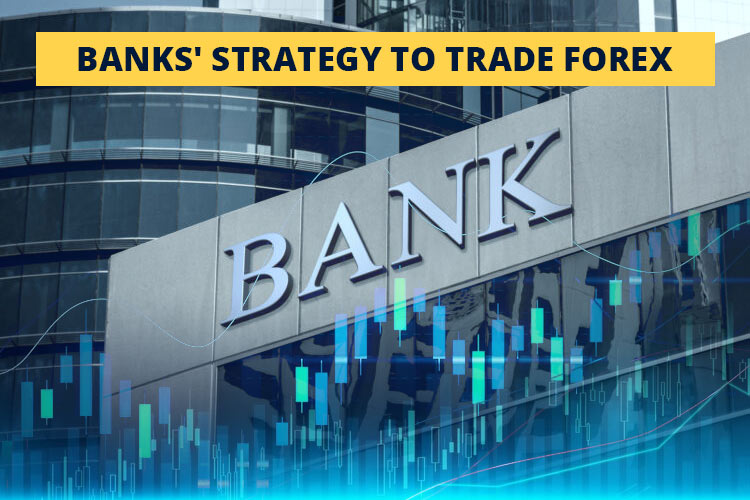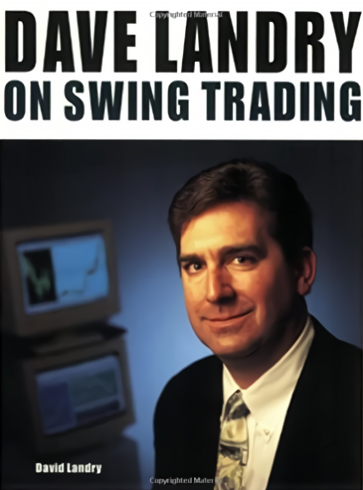Did you know that banks are the biggest players in the forex market? Read further to find out how banks execute their trades and what we can learn from them.

More than 60% of the total daily volume in the forex market is controlled by bank traders. Those transactions take place in the interbank market, which is the global network of banks that is spread across four trading centers, such as New York, London, Sydney, and Tokyo.
However, it's worth noting that most of the time, banks are simply transacting on behalf of their clients' requests. That means they may perform thousands of transactions per day but it's possible that none of them are made by their own accounts.
Instead, banks usually trade with their own account perhaps only 2-3 times a week. The reason is that banks are big players and market drivers. They only trade in big positions and trade for the long-term, usually weekly or monthly.
The 3 Phases of Bank Trading Strategy
Essentially, institutional or smart money traders like banks use a wide range of strategies, but in general, their trading decisions can be summarized into a three-step process.
This is often referred to as the Dow Theory, which was developed by Charles Dow, the founder of Dow Jones & Company, Inc. and the co-founder of the Wall Street Journal.
In this theory, Dow believed that by analyzing the market as a whole, one could identify the major market trends and the likely direction of those trends.
Phase 1: Accumulation
In the first phase of the strategy, smart money players typically start out by buying and selling in relatively small amounts. Unlike regular retail traders, bank traders have so much power in the market, so they tend to avoid trading their money all at once since it can drastically impact the market.
Instead, they would enter the market frequently and make money by accumulating small positions. They could either accumulate their long positions and later sell them off at a higher price or accumulate short positions and later buy it back at a lower price.
Being able to spot such activity on the chart is a very useful skill for retail traders. If you can identify where the big players are accumulating, you will also be able to tell the direction that they're aiming for and take advantage of it.
Phase 2: Manipulation
As the name suggests, this step is where the banks are trying to manipulate the market with their actions.
Traders often get manipulated by thinking that there's going to be a breakout, only to find out that it is a false push and the trend immediately changes direction after that.
This is actually quite common in the forex market, so it's not surprising that many traders fall for it. The manipulation phase always happens right after the accumulation phase and it is characterized by a short-term market trend.
The reason why banks like to manipulate the market is that they need to create liquidity for themselves due to their giant trade positions. Therefore, they need to "manipulate" the traders into going a certain direction before taking the opposite position in order to take profit.
Nevertheless, it is bad news for retail traders. So in order to identify the manipulation trick, you need to pay attention to the high and low of the accumulation phase. In a bearish market, a false push that occurs above the accumulation phase shows that the banks are selling.
Meanwhile, in a bullish market, a false push that occurs below the low of the accumulation phase shows that the banks are actually buying.
Phase 3: Distribution
Once you learn how to avoid being a pawn of market manipulation, it's time to make an actual profit from your trades. Distribution is the final phase where banks push the price to create the real trend.
In other words, they no longer play tricks and are beginning to show their true goal. This phase is the easiest to spot but also very crucial, so make sure that you catch the correct signal from the previous two phases.
Remember that a distribution phase must occur after the manipulation phase ends, so only enter when you get a valid confirmation signal for trade entry.
How to Trade Like a Bank Trader
Banks are institutional players in the market, but we must not forget that they also consist of regular people like you and me. In terms of grand trading strategy, it's not wise to straight-up copy the bank's approach because we have different capabilities.
Retail traders don't have big trading positions and market influence like banks do. However, you can improve your skills by learning from bank traders and seeing how they do their jobs.
Here's a series of tips that you can follow:
Set Your Target
Most bank traders have minimal annual earning goals. This helps them visualize their targets better and gives them the motivation to reach those targets.
They would also break down the target into monthly and even weekly goals so that they could get a sense of how much they need to earn in a specific period of time.
This way, the target won't feel impossible to grasp because it's already broken down into smaller portions. The key is to make consistent returns from each trade.
Know Your Limit
Apart from setting targets, bank traders also set their limits, both in position size and drawdown limits. Setting limits is important to them because they're trading with other people's money.
Therefore, violating these limits can certainly affect their career performance negatively.
Since retail traders trade with their own money, the consequences are more personal, so they won't harm anyone but themselves if they lose. However, this doesn't mean that limits aren't relevant.
On the contrary, it is highly necessary to manage your funds and keep your losses in check.
Make a Routine
Bank traders have a huge responsibility, so they simply can't afford to lose. They would wait for the best market opportunity before entering the trade. This is partly what makes banks generate profit from almost all their trades.
Meanwhile, retail traders often "make time" to trade since they usually have other jobs apart from trading. Unfortunately, this won't cut it. What you need to do is wait for the market to be present with trading opportunities, not the other way around.
You can't force the market to be profitable if the reality is clearly the opposite. Therefore, it's better to avoid trading when the market's not favorable and wait for the right moment before trading to avoid unnecessary loss.
Reset Each Day
Bank traders don't trade with their own money, so getting losses won't leave a big damaging impact on them mentally, although it can definitely ruin their career and bonuses at some point.
That being said, it's easier for them to recover from the losses since they don't really feel the direct impact on their financial situation. Meanwhile, retail traders use their own money, so losing trade can be quite a traumatic experience, especially at the beginning of their trading journey.
You need to be able to control your emotions and accept that loss is sometimes unavoidable in forex trading. Remember that emotional trading often leads to even bigger losses.
Therefore, it is important to reset each day and let the past stay in the past. The best thing you can do is learn from yesterday's mistakes and make them the basis for today's success.
Keep It Lowkey
Bank traders don't use a lot of indicators, so their charts are not cluttered with mathematical formulas and colored lines. Instead, they just need to highlight critical levels on the chart, such as Support and Resistance.
Working in a bank with other traders can definitely save someone from being overconfident. They need to be able to work as a team, so there's no space for big-headed traders who think they know it all. This can be quite an issue with retail traders, though.
Sometimes it's hard to control your overconfidence after a series of winning trades. Even so, you need to be realistic and maintain the winning streak. Remember that getting consistent returns in the long term is what you would want to aim for.
In the end, forex trading is not something that one could easily master in a week or two. In order to build the best trading strategy, you need to learn about the various trading strategies available on the market, including the ones used by big players such as banks.
Still, keep in mind that it takes practice to see the true intention behind the market movements. So, take your time and be patient.

 Dedicated FREE FOREX VPS
Dedicated FREE FOREX VPS Free FOREX Virtual Private Server
Free FOREX Virtual Private Server MT4 Demo Contest, Get $500
MT4 Demo Contest, Get $500 Sign Up for an Account, Claim 60% Deposit Bonus
Sign Up for an Account, Claim 60% Deposit Bonus Free MT4/MT5 VPS 2024
Free MT4/MT5 VPS 2024 Send E-mail and Get Free Merchandise
Send E-mail and Get Free Merchandise $1K Refer a Friend Bonus for Pepperstone Pro clients
$1K Refer a Friend Bonus for Pepperstone Pro clients Maximize Your Earnings with 100% Deposit bonus
Maximize Your Earnings with 100% Deposit bonus Trade to Win, $5,000 Monthly Demo Contest
Trade to Win, $5,000 Monthly Demo Contest Claim 30% + 15% Deposit Bonus from LiteFinance
Claim 30% + 15% Deposit Bonus from LiteFinance














1 Comment
Claude
Dec 26 2022
I'm curious how banks can generate revenue. So it's a big bank. All I know is that banks earn income from interest on loans, either from mortgages or loans. But looking at how the bank restores and maintains software, communication costs, employees, etc. every month, I think the interest rates are actually too low to make a profit. In my wildest assumptions after reading this article. Are banks also benefiting from trading forex? And do most of their income come from forex trading? And did they use brokers like regular traders?